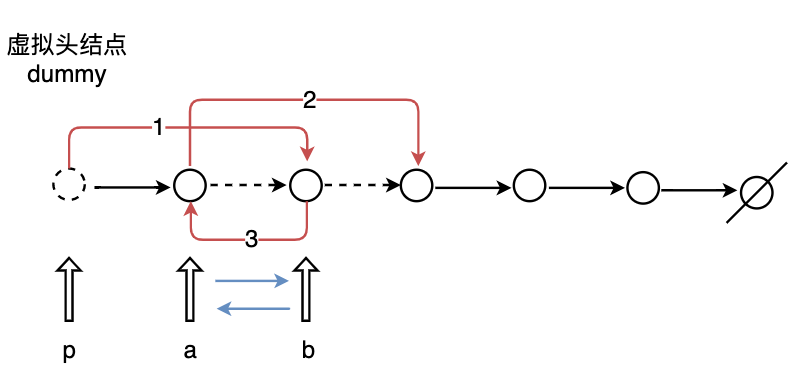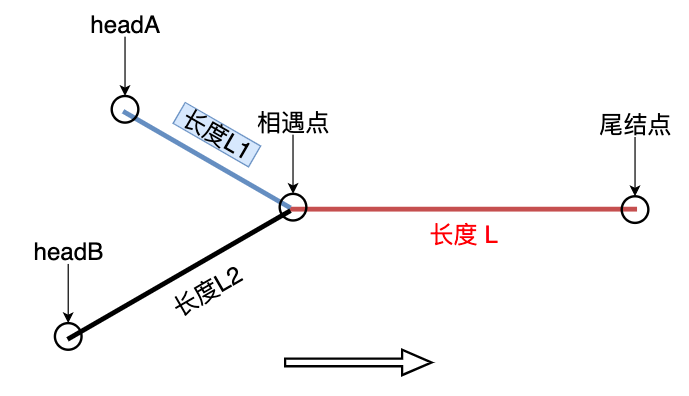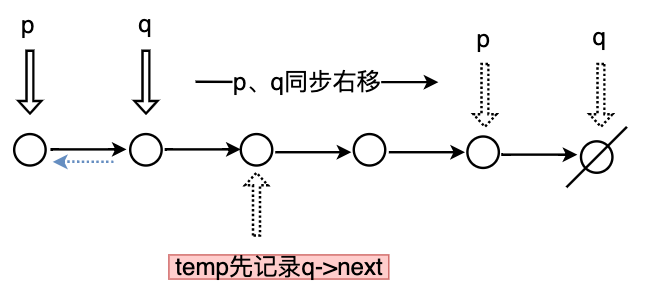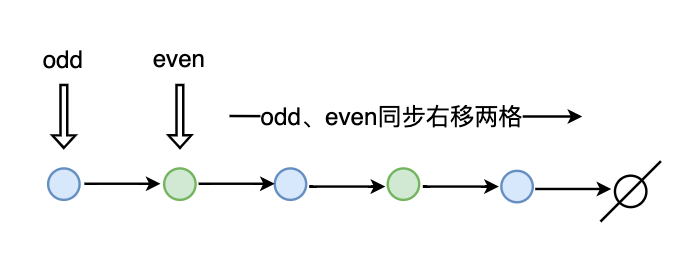链表是一种非常基础的数据结构,其中算法的题目难度一般都不是很大,重点在于画图理解、处理好边界条件和保留相关节点信息防止遍历后找不到所需节点
题目列表
- 19. 删除链表的倒数第N个节点
- 21. 合并两个有序链表
- 24. 两两交换链表中的节点
- 83. 删除排序链表中的重复元素
- 160. 相交链表
- 206. 反转链表
- 234. 回文链表
- 328. 奇偶链表
- 445. 两数相加 II
- 725. 分隔链表
删除链表的倒数第N个节点
- 先统计链表中有个结点
- 找到倒数第个节点
- 删除
class Solution {
public:
ListNode* removeNthFromEnd(ListNode* head, int n) {
auto dummy = new ListNode(-1);
dummy->next = head;
// 记录链表一共有多少个节点
int sum = 0;
while (head != nullptr) {
sum++;
head = head->next;
}
// 找到倒数第 n + 1个节点
auto p = dummy;
for (int i = 0 ; i < sum - n; i++)
p = p->next;
p->next = p->next->next;
return dummy->next;
}
};
合并两个有序链表
双指针
- 关键在于定义虚拟头结点,防止返回结果找不到头结点
class Solution {
public:
ListNode* mergeTwoLists(ListNode* l1, ListNode* l2) {
if (l1 == nullptr)
return l2;
if (l2 == nullptr)
return l1;
// 定义虚拟头结点
ListNode* dummy = new ListNode(-1);
ListNode* tail = dummy;
// 归并
while (l1 != nullptr && l2 != nullptr) {
if (l1->val < l2->val) {
tail->next = l1;
l1 = l1->next;
}
else {
tail->next = l2;
l2 = l2->next;
}
tail = tail->next;
}
if (l1 != nullptr)
tail->next = l1;
if (l2 != nullptr)
tail->next = l2;
// 返回链表:不返回虚拟头结点
return dummy->next;
}
};
递归
class Solution {
public:
ListNode *mergeTwoLists(ListNode *l1, ListNode *l2) {
if (l1 == nullptr)
return l2;
if (l2 == nullptr)
return l1;
if (l1->val < l2->val) {
l1->next = mergeTwoLists(l1->next, l2);
return l1;
} else {
l2->next = mergeTwoLists(l1, l2->next);
return l2;
}
}
};
两两交换链表中的节点
- 注意这里和反转链表的区别:两两交换相邻的节点
- 每次指向要交换两个结点的前一个结点

class Solution {
public:
ListNode* swapPairs(ListNode* head) {
if (head == nullptr || head->next == nullptr)
return head;
// 建立虚拟头结点
auto dummy = new ListNode(-1);
dummy->next = head;
auto p = dummy;
while (p->next != nullptr && p->next->next != nullptr) {
auto a = p->next;
auto b = p->next->next;
p->next = b;
a->next = b->next;
b->next = a;
p = a;
}
return dummy->next;
}
};
删除排序链表中的重复元素
- 找到结点值相同的结点删除
class Solution {
public:
ListNode* deleteDuplicates(ListNode* head) {
if (head == nullptr || head->next == nullptr)
return head;
auto p = head;
while (p->next != nullptr) {
if (p->val == p->next->val) {
p->next = p->next->next;
}
else
p = p->next;
}
return head;
}
};
相交链表

- 走到尾结点的时候,将指针指向往前走;走到尾结点的时候,将指针指向往前走
- 走到相交点的时候:走的总路程都是
class Solution {
public:
ListNode *getIntersectionNode(ListNode *headA, ListNode *headB) {
if (headA == nullptr || headB == nullptr)
return nullptr;
ListNode* pa = headA;
ListNode* pb = headB;
while (pa != pb) {
if (pa == nullptr)
pa = headB;
else
pa = pa->next;
if (pb == nullptr)
pb = headA;
else
pb = pb->next;
}
return pa;
}
};
反转链表
迭代

class Solution {
public:
ListNode* reverseList(ListNode* head) {
if (head == nullptr)
return nullptr;
ListNode* p = head;
ListNode* q = head->next;
while (q != nullptr) {
ListNode* temp = q->next;
// 改变指针走向
q->next = p;
// 顺次往后移动
p = q;
q = temp;
}
head->next = nullptr;
return p;
}
};
递归
class Solution {
public:
ListNode *reverseList(ListNode *head) {
if (head == nullptr || head->next == nullptr)
return head;
ListNode *tail = reverseList(head->next);
head->next->next = head;
head->next = nullptr;
return tail;
}
};
回文链表
- 要使用的空间来做:那么我们就不能遍历时候将节点值存储下来去判断
- 先统计链表中节点的个数
- 向下取整是链表的一半(向下取整目的为了无需判断奇偶数的影响,跳步一定是后一半的头结点)
- 从头结点开始跳步找到后一半的头结点
- 将后半部分反转次(反转链表操作)
- 双指针判断是否是回文链表
- 将后半部分链表恢复(否则过不了LeetCode评测)
class Solution {
public:
bool isPalindrome(ListNode* head) {
// 记录链表一共有多少个结点
int n = 0;
auto p = head;
while (p != nullptr) {
p = p->next;
n++;
}
if (n <= 1)
return true;
int half = n / 2;
auto a = head;
// 跳 n - half次到后面一半的头结点
for (int i = 0; i < n - half; i++)
a = a->next;
auto b = a->next;
// 翻转 half - 1 次
for (int i = 0; i < half - 1; i++) {
auto c = b->next;
b->next = a;
a = b;
b = c;
}
// 双指针判断是否回文链表
p = head;
auto q = a;
bool res = true;
for (int i = 0; i < half; i++) {
if (p->val != q->val) {
res = false;
break;
}
p = p->next;
q = q->next;
}
// 将链表恢复:再次翻转 half - 1 次
auto tail = a;
b = a->next;
for (int i = 0; i < half - 1; i++) {
auto c = b->next;
b->next = a;
a = b;
b = c;
}
tail->next = nullptr;
return res;
}
};
奇偶链表

class Solution {
public:
ListNode* oddEvenList(ListNode* head) {
if (head == nullptr || head->next == nullptr)
return head;
auto odd = head, evenhead = head->next, even = evenhead;
while (even != nullptr && even->next != nullptr) {
odd->next = odd->next->next;
even->next = even->next->next;
odd = odd->next;
even = even->next;
}
odd->next = evenhead;
return head;
}
};
两数相加 II
class Solution {
public:
/**
* @brief 高精度加法
* @param a
* @param b
* @return vector<int>
*/
static vector<int> add(vector<int>& a, vector<int>& b) {
vector<int> c;
int t = 0;
for (int i = 0; i < a.size() || i < b.size(); i++) {
if (i < a.size())
t += a[i];
if (i < b.size())
t += b[i];
c.push_back(t % 10);
t /= 10;
}
if (t > 0)
c.push_back(1);
return c;
}
ListNode* addTwoNumbers(ListNode* l1, ListNode* l2) {
vector<int> v1, v2, res;
while (l1 != nullptr) {
v1.push_back(l1->val);
l1 = l1->next;
}
while (l2 != nullptr) {
v2.push_back(l2->val);
l2 = l2->next;
}
reverse(v1.begin(), v1.end());
reverse(v2.begin(), v2.end());
res = add(v1, v2);
auto dummy = new ListNode(-1), p = dummy;
for (int i = res.size() - 1; i >= 0; i--) {
p->next = new ListNode(res[i]);
p = p->next;
}
return dummy->next;
}
};
分隔链表
class Solution {
public:
vector<ListNode*> splitListToParts(ListNode* root, int k) {
vector<ListNode*> res;
int n = 0;
auto p = root;
while (p != nullptr) {
n++;
p = p->next;
}
int a = n / k;
int b = n % k;
p = root;
// b个组元素是 a + 1个
for (int i = 0; i < b; i++) {
auto dummy = new ListNode(-1), q = dummy;
for (int i = 0; i < a + 1; i++) {
q->next = new ListNode(p->val);
q = q->next;
p = p->next;
}
res.push_back(dummy->next);
}
// k - b个组元素是 a 个
for (int i = 0; i < k - b; i++) {
auto dummy = new ListNode(-1), q = dummy;
for (int i = 0; i < a; i++) {
q->next = new ListNode(p->val);
q = q->next;
p = p->next;
}
res.push_back(dummy->next);
}
while (res.size() < k)
res.push_back(nullptr);
return res;
}
};
